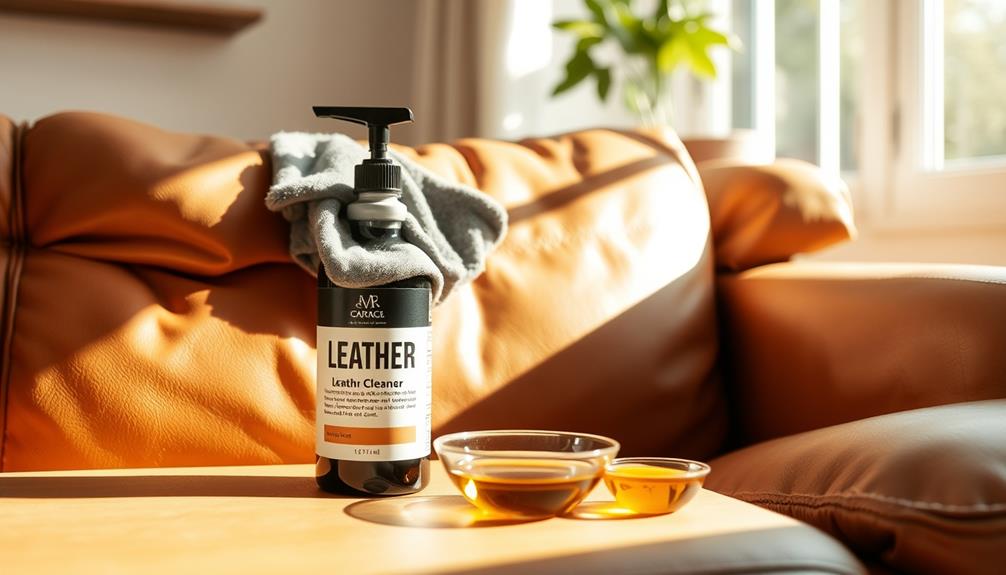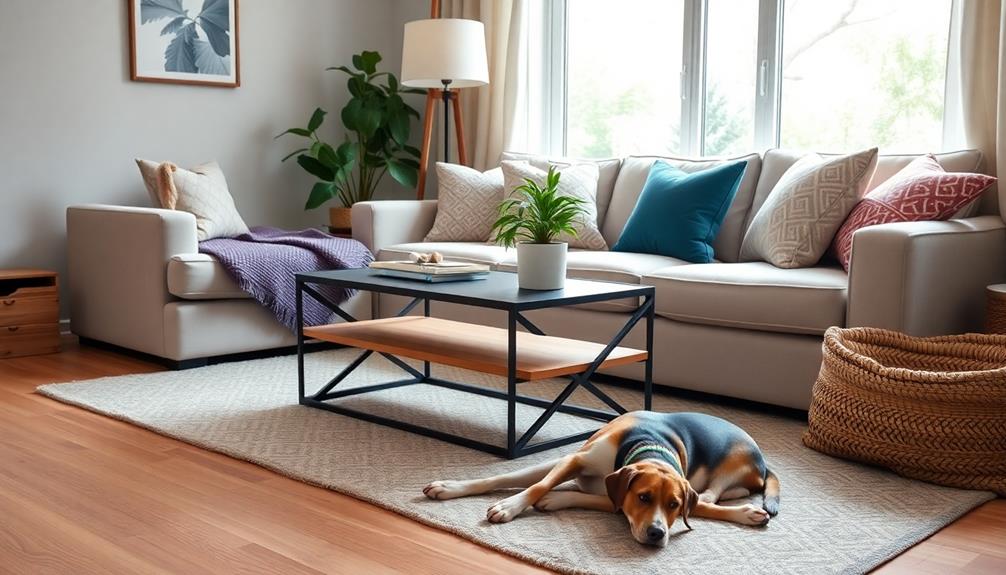To clean leather furniture, begin by dusting with a gentle microfiber cloth or vacuum attachment. Make a solution of equal parts vinegar and warm water for a mild cleaning solution, testing it on a hidden spot first. For specific stains, dab ink with rubbing alcohol or address grease with cornstarch. Always allow the leather to completely air dry, avoiding direct sunlight to prevent fading. Conditioning every 6 to 12 months will help keep the leather soft and resilient. Consistent upkeep and proper methods ensure your furniture remains beautiful. Want more useful tips? There’s a lot more to come! Interested in more helpful advice on caring for your furniture? Be sure to take a look at our fabric sofa cleaning tips. With the proper care, your leather or fabric furniture can last for years, adding both beauty and comfort to your space. So, be sure to stay on top of regular cleaning and maintenance to preserve the appearance of your furniture.
Key Takeaways
- Dust leather furniture regularly with a soft microfiber cloth or vacuum attachment to remove loose dirt and contaminants.
- Create a cleaning solution of equal parts vinegar and warm water, testing it on an inconspicuous area first.
- For specific stains, use rubbing alcohol for ink and cornstarch for grease, then allow to air dry.
- Condition leather every 6 to 12 months with a suitable product to maintain softness and prevent cracking.
- Avoid water-based cleaners, harsh chemicals, and steam cleaning to protect the integrity of the leather.
Cleaning Techniques for Leather
When cleaning leather furniture, start by dusting it with a soft microfiber cloth or a vacuum attachment to remove any loose dirt and debris. Next, you can mix a solution of mild soap and water to gently clean the surface of the leather. Be sure to test the solution on a small, inconspicuous area first to ensure it doesn’t cause any discoloration. After cleaning, allow the furniture to air dry completely. If you’re still having trouble removing cigarette odors, you can try using a leather cleaner specifically designed to tackle stubborn smells.
It's important to guarantee that the area is free of any contaminants, as dirt can scratch the leather during the cleaning process.
Once the surface is clear, you can create a cleaning solution using equal parts vinegar and warm water. Dampen a soft cloth with this mixture and gently apply it in circular motions to avoid spreading any stains. For tips on keeping leather clean, consider professional cleaning services that specialize in maintaining furniture.
Before applying this solution to the entire piece, it's essential to test it on an inconspicuous area to confirm it won't damage or discolor the leather.
If you encounter specific stains, handle them carefully: blot ink stains with rubbing alcohol on a cotton swab, and treat grease stains by sprinkling cornstarch on the area to absorb the oil.
After you've cleaned the leather, let it air dry completely, steering clear of direct sunlight, which can cause fading.
Remember, maintaining your leather furniture also involves using a leather conditioner every 6-12 months to keep it soft and prevent cracking.
Conditioning and Protecting Leather
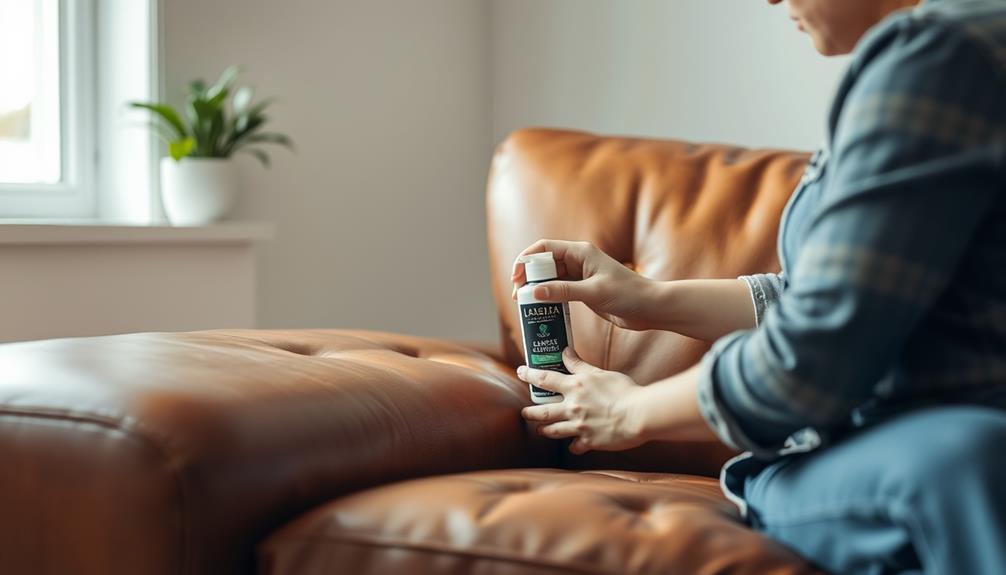
To keep your leather furniture looking its best, conditioning and protecting it's crucial. Aim to condition your leather every 6 to 12 months using a mixture of natural soap, vinegar, and water, or a commercial leather conditioner.
Before applying any conditioner, it's important to test the solution on an inconspicuous area to verify it won't alter the color or texture. Additionally, consider using essential oils like peppermint oil for their invigorating scent, which can help create a pleasant atmosphere in your home while you care for your leather.
Once you've conditioned the leather, consider applying a protector spray specifically designed for leather. This can enhance durability and resistance to stains, helping maintain its appearance over time.
After conditioning, regularly buff your leather furniture with a soft cloth to restore its shine and improve its overall aesthetics.
Additionally, to prevent drying and cracking, always keep your leather furniture out of direct sunlight and away from heat sources. These elements can accelerate deterioration and compromise the material's softness.
Stain Removal Methods
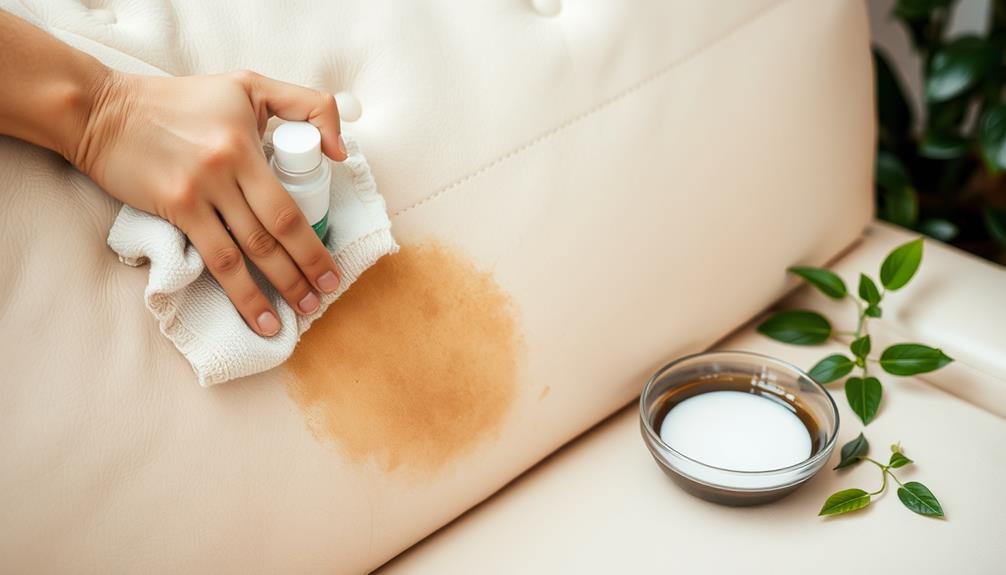
Even with regular conditioning and protection, accidents happen, and stains can mar the beauty of your leather furniture. When it comes to stain removal, prompt action is key.
For grease stains, start by blotting the area with a paper towel. Then, sprinkle cornstarch on the stain, letting it absorb the oil for several hours before vacuuming it off. To maintain the cleanliness of your home, consider using a vacuum designed for dust removal to tackle any debris that may accumulate around your leather furniture.
To tackle ink stains, gently blot the affected area using a cotton swab soaked in rubbing alcohol. Afterward, dry the spot with a blow dryer on a low setting to prevent spreading.
For blood stains, use a clean cloth to blot, then apply a solution of soda water or soapy water to lift the stain without soaking the leather.
Coffee stains can be managed by blotting with a paper towel and wiping gently with a damp cloth.
For makeup stains, first, blot the excess makeup, then clean the area with a damp cloth and mild soap. Finally, sprinkle cornstarch to absorb any residual oil and vacuum it up.
These simple stain removal methods will help keep your leather furniture looking its best.
Maintenance Tips for Longevity
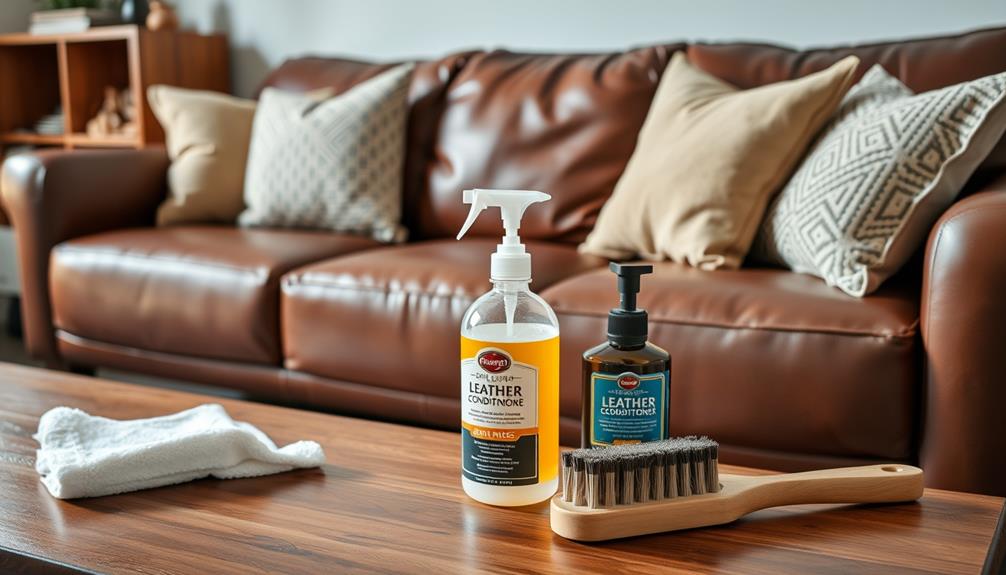
Maintaining the beauty and durability of your leather furniture requires consistent care and attention. Here are some essential tips to guarantee its longevity:
| Task | Frequency |
|---|---|
| Dust with a soft microfiber cloth | At least once a month |
| Condition leather | Every 6 to 12 months |
| Address spills and stains immediately | As they occur |
Regularly dust your leather furniture with a soft microfiber cloth to prevent dirt buildup that can lead to scratches and wear. Conditioning your leather every 6 to 12 months helps maintain softness and prevents cracking, preserving its appearance.
Keep your leather pieces away from direct sunlight and heat sources to avoid fading and drying out. For spills and stains, always blot them immediately with a clean cloth, using appropriate cleaning solutions as needed to prevent permanent marks.
Enhance durability by applying protective sprays formulated for leather, which can also help resist stains. Finally, consider professional cleaning for deep maintenance when necessary to keep your furniture looking its best. By following these maintenance tips, you can guarantee your leather furniture remains beautiful and functional for years to come.
Products to Avoid on Leather
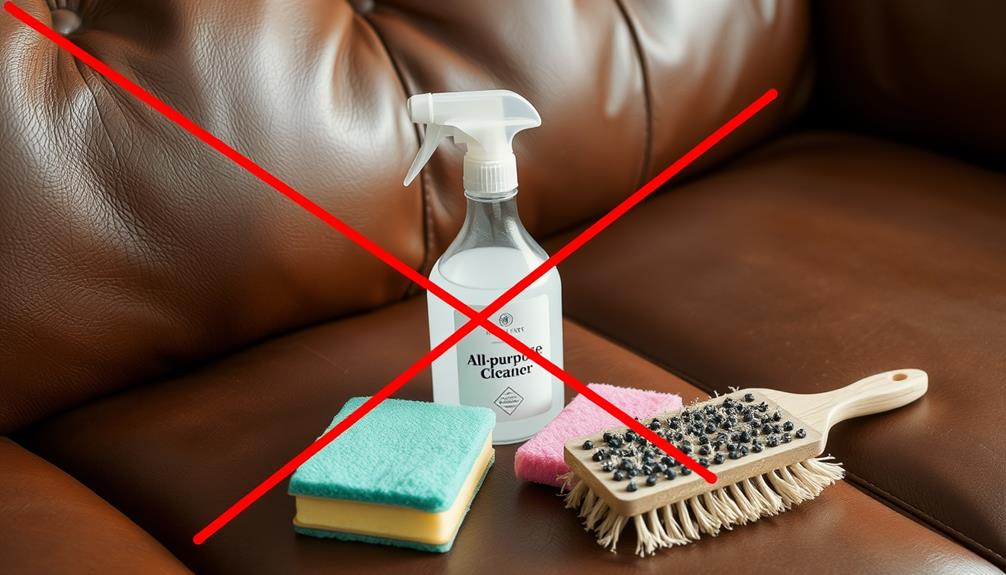
Proper maintenance is key to extending the life of your leather furniture, but knowing what products to avoid is just as important.
First and foremost, steer clear of water-based cleaners. These can damage leather by causing it to swell and lose shape due to its porous nature. Oily substances, like mink oil, should also be avoided; they create a greasy residue that deteriorates leather's surface.
Additionally, refrain from using shoe polish. It can leave stains and residues that are difficult to remove from leather upholstery. Harsh chemicals, such as bleach and ammonia, are detrimental too; they strip leather of its natural oils, leading to cracking and discoloration over time.
Lastly, don't use steam cleaning. While it might seem effective, the heat and moisture can age leather prematurely by removing essential fats and oils, compromising its integrity.
Frequently Asked Questions
What Is the Best Thing to Clean a Leather Couch With?
To clean your leather couch, try a mix of equal parts white vinegar and warm water. Use a microfiber cloth in circular motions, ensuring you test any solution on an inconspicuous area first to avoid damage.
Can You Use Dawn Dish Soap to Clean Leather Furniture?
You might think Dawn dish soap's tough on grease, so it's safe for leather. But, it needs dilution and testing first! It can clean effectively, but you've got to be careful to avoid damage.
How Do You Clean Leather Without Ruining It?
To clean leather without ruining it, always test your cleaning solution first. Use a gentle 50/50 vinegar-water mix on a damp cloth, and avoid soaking the leather. Regular conditioning keeps it soft and prevents damage.
Does Vinegar Damage Leather?
Yes, vinegar can damage leather if used improperly. It may strip natural oils, leading to dryness. Always dilute it, test on hidden areas first, and follow up with a conditioner to maintain leather's suppleness.
Conclusion
Taking care of your leather furniture might seem intimidating, but it's easier than you think. By using the right cleaning techniques and products, you can keep your leather looking great for years. Don't worry if you make a mistake; leather's resilience means it can often be restored. Embrace regular maintenance to prevent issues before they arise. Remember, a little effort now can save you from costly repairs later, allowing you to enjoy your beautiful furniture worry-free.
